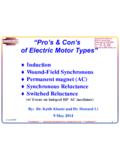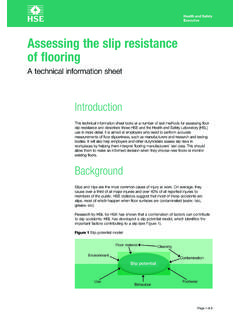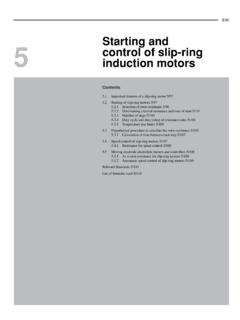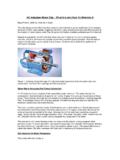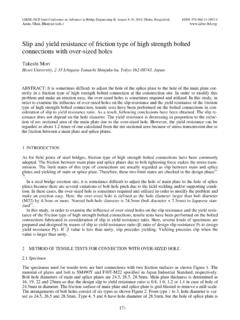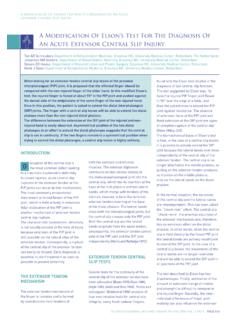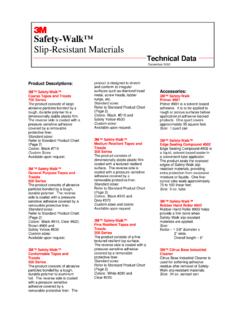Transcription of Carbon Brush Performance on Slip Rings
1 Carbon Brush Performance on slip Rings Richard D. Hall Morgan AM&T. Roland P. Roberge Morgan AM&T. Gary Lozowski Morgan AM&T. Mining Electrical Maintenance and Safety Association September 9, 2010 Clearwater, FL. Machines that use Carbon Brushes on slip Rings Carbon Brushes slip Rings Synchronous Motor or Generator Synchronous Motor Constant speed Very efficient Three phase windings in stator (rotating magnetic field). DC fields on rotor DC excitation supplied through Carbon brushes on two slip Rings (collector Rings ). Synchronous Motor Typical Brush current density 75. Amps/in2 ( Amps/cm2) or less Collector Rings are generally Carbon steel or bronze Sync Motor Collector Rings Wound Rotor Induction Motor Variable speed Three phase windings in stator (rotating magnetic field). Three phase windings in rotor Three phase (variable frequency) current induced in rotor Rotor current brought out to variable resistance/electronic controls through brushes on three slip Rings to control speed Wound Rotor Induction Motor Typical Brush current density varies widely depending on motor design and application from about 75 Amps/in2 ( Amps/cm2) to 125 Amps/in2 ( Amps/cm2).
2 Collector Rings are most often bronze or stainless steel Wound Rotor Motor Three slip Rings Turbine Generator Turbine generator Brush rigging with change on the fly . removable Brush holders Turbine Generator Synchronous generator Extremely efficient Converts mechanical energy to AC electrical energy with steam or gas turbine as prime mover Three phase windings in stator (rotating magnetic field). DC Fields on rotor DC excitation supplied through Carbon brushes on two slip Rings (collector Rings ). Steam Turbine Generator Typical Brush current density 40. Amps/in2 ( Amps/cm2) to 65. Amps/in2 (10 Amps/cm2). Collectors Rings are almost always steel or sometimes stainless steel Surface speeds up to 16,000 Feet per minute ( 182 MPH, 81 mps ). Brush Selection and Collector ring Filming Brush Material Selection Brushes and collectors form a sliding electrical contact Brushes are selected based on the current density, ring material and surface speed The original equipment supplier (OEM) will have selected grades, but grade changes may be made if the machine operates at conditions different than rated Typical Brush Materials Used Brush Material Rated Current Metal Content Density %.
3 Amp/in2 Amp/cm2. Graphite 65 0. Electrographite 80 0. Copper Graphite 100 50. Copper Graphite 125 75. Brush Wear Mechanical Frictional wear Electrical Material removed with the flow of current Thermal With heat some Carbon oxidizes into CO2. Film provides a low friction surface Common Collector ring Materials Bronze Resistance to chemical reactions. Limited speed capability. Good friction characteristics. Steel Good mechanical strength. Can oxidize under Brush at standstill or rust Stainless steel Contamination resistance. May have higher Brush contact drop and selectivity Brush Holders Brushes must be held in contact with the ring for good Performance The holders must be supported so they do not vibrate Clock spring holders are a poor selection where there is vibration and must be adjusted as brushes wear Constant pressure holders are common on newer machines or retrofits Adjustable Clock Spring Clock Spring Holders A Different Style Adjustable Spring Ladder Back Holder Short Style Brush Holder Not Preferred Full Length Brush Holder Preferred Brush Holder Alignment and Design Concerns Constant Pressure Springs Constant Pressure.
4 (Non-Adjustable). Spring Brush holders set too high Brush holder clearance to the Rings should be set to manufacturer's recommendation. This is typically about ( 1/8 ) maximum Brush Holder A longer holder would be better for Brush stability Brush Holder alignment OK, exactly perpendicular to the slip ring surface or commutator surface slip ring or Commutator Rotation Brush Holder alignment , not the best, but 1 or 2. degrees trailing is OK. slip ring or Commutator Rotation Brush Holder alignment needs adjustment. This is called leading or stubbing and can cause fast wear or friction chatter. Just 1 or 2. degrees makes a big difference. slip ring or Commutator Rotation Not Good One Brush trailing, one leading Normal Performance Uniform film appearance with no burn marks No signs of excessive ring wear No visible sparking Brush faces uniform with no sign of burning Minimal side polish . from Brush movement Good Brush life Two excellent tools for accessing Rings Feeler Stick Strobe Light Collector condition for good Performance Total Indicator Runout Inches (micron).
5 Preferred (25). Allowable (76). Surface speed and type of TIR affects Brush Performance ..00044 TIR. 3600 RPM. slip ring .00044 TIR. 3600 RPM. slip ring u sh Br Small BUMP on slip ring OD may .00044 TIR. cause problems 3600 RPM. slip ring p g 1. 200. 20. 180 3 ring 40. slip ring Assembly 160 Each ring has 60. a different Profile 140. 80 See next 2 slides 120 100. Profiler MAS - slip ring - Radial Plot 1. 220. 20. 200. 40. 180. 60. 160. 80. 140. 100. 120. 20 00 20 20 00 20. Profiler MAS - slip ring - Radial Plot 1. 200. 20. 180. 40. 160. 60. 140. 80. 120. 100. 20 00 -2 0 -2 0 00 20. Collector ring Conditions Foot Printing (photo Imaging/ghosting). Images appear on the ring that initially reflect the size of the Brush face and Brush spacing Erosion from arcing makes low spots . The marks may spread out over time and make the ring surface not round Sometimes the ring looks like the Brush is bouncing or skipping Foot Printing Turbine Generator Photo Imaging - Advanced Foot Printing Simultaneous loss of contact The initial trigger is a mechanical disturbance The damage to the ring is from subsequent electrical erosion Eventually, the initial marks may spread out and not be visible, but the ring will go out of round Damage is progressive and gets worse at an increasing rate Foot Printing Mechanical triggers Out of balance rotor High friction area on ring Brush instability Contamination High friction in Brush holders.
6 Slow to respond springs Corrosion under brushes from moisture when brushes left in contact with the ring at standstill Foot Printing The strobe light is an excellent tool for spotting foot printing early so corrective action can be taken before damage progresses too far Foot Printing Corrective Action Increase Brush pressure to shorten periods of bounce Eliminate contamination/high friction areas on Rings Do not allow machines to remain idle for long periods with the brushes down Increase the number of brushes per ring to increase the chance at least one Brush will be in contact Reposition brushes to increase the arc of contact Foot Printing _ Corrective Action Make sure rotors are properly balanced Have Brush holders properly aligned for Brush stability Do not sandblast Brush holders and eliminate burrs so brushes can move freely Foot Printing Removed Turbine Generator ring After Machining Threading Under normal conditions some metal is removed from the Rings and is vaporized Sometimes the metal does not completely vaporize and transfers into the Brush face These small particles work harden, becoming harder than the ring surface They then cut into the ring making what look like fine pitch threads.
7 Threading Brush Face . Threading Microscopic View of Copper in Brush Face Threading Low Brush current decreases metal vaporization and can increase threading Sulfur containing gasses (SO2, H2S). increase metal transfer and threading Low Brush pressure increases metal transfer and threading Typical Proper Brush Pressures Application Brush Pressure PSI (Kg/cm2). Industrial 2 4 ( ). Turbine Gen. 2 ( ). Low speed or 4 ( ). Higher Vibration Threading Corrective Action Reduce atmospheric contamination (not easy). Make sure Brush pressure is adequate Check Brush current density and use a graphite grade for low current density Use caution in removing brushes to increase Brush current density as foot printing may become a problem Grooving Grooving is uniform wear around the circumference of the Rings There will always be some mechanical and electrical wear of the Rings However, the rate should not be high enough to require frequent ring maintenance Excessive mechanical wear can be caused by abrasive Brush grades Low Brush pressure can increase electrical wear Grooving Steel and stainless steel Rings are more resistant to mechanical wear than bronze Rings ring Grooving ring Grooving ring Grooving p g 10.
8 100 1. 10. 0. -10. 90. 20. Radial Scale ( +/- 10 Mils). 80. 30. 70. 40. -10. 0. 60. 10 50. 10 0 -10 -10 0 10. Recording Plot Rec# Recording start Size TIR Max STS Mean STS Std dev Suspect Remark ABB Path # 2 16 18 Nov 2009 ( 4:02:34 am) 106 Segments mil : 24-10 : 19-20 0. Polarity Wear One ring may wear more than the other, especially on synchronous motors or generators where the polarities are separate Proper Brush pressure reduces the wear Reversing polarities periodically can make the wear more even. This is like rotating the tires on a car Grooving Corrective Action Make sure Brush pressure is adequate Do not use Brush grades that have more polishing action (abrasiveness) than is required Brushes with some polishing action may be required on steel Rings or in contaminated environments To reduce polarity wear reverse leads to Brush holders periodically Selectivity The brushes on collector Rings operate in electrical parallel with each other The brushes never wear at the same rate Uneven currents in the parallel paths will affect Brush wear rates The brushes with higher current and temperature generally wear faster Mechanical friction restricting movement of the Brush in the Brush holder.
9 Selectivity - Typical Voltage Drops at 100 Amperes in the Brush Brush rigging to cable 1 mV. Brush box to support 1 mV. Brush terminal to holder 1 mV. Terminal to shunt wire 1 mV. Shunt to Carbon (2 shunts) 150 mV. Carbon material 120 mV. Contact drop ( Brush to ring ) 1000 mV. Selectivity The largest resistance in the parallel paths is the contact drop between the Brush and the ring The contact drop has the largest influence on selectivity Selectivity Corrective Action To minimize selectivity, the resistances in the parallel paths must be as consistent as possible Brush manufacturer's responsibility Resistivity of the Carbon tightly controlled Terminals applied correctly Tamped or riveted connections to the Carbon should have equal and low resistance Dirty Brush holders and springs will affect Performance Selectivity Corrective Action Maintenance personnel responsibility Electrical connections clean and tight Brush box to rigging clean and tight Ensure Brush moves freely in the Brush holder Selectivity Corrective Action Adjustable Brush springs must be adjusted for equal Brush pressure Constant pressure springs age from heat and vibration and should be replaced periodically ( 5 years).
10 Do not mix Brush grades in a machine Minimize contamination on the Rings Minimize Brush and machine vibration Selectivity Corrective Action Use a collector ring material suitable for the application Use a Brush with the proper current density rating Selectivity Corrective Action - Helical grooves in Rings force current to move around in Brush faces preventing localized hot spots Selectivity Corrective Action A diagonal slot in Brush can help reduce selectivity Loss of Brush Contact Arcing between the Brush and ring can deteriorate Brush life and damage the ring surface Weak Brush springs Brushes hung up in holders Vibration Brushes allowed to wear too short Brush Worn Too Short Badly Pitted Stainless Steel ring Short Brushes Metal Transfer to Brush Brushes Run Too Short Loss of Brush Contact . Corrective Action Maintain Brush springs to keep good Brush pressure Make sure brushes can move freely in the holders Minimize machine vibration Replace brushes in a timely fashion.
